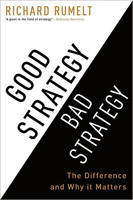
|
 |
Good Strategy Bad Strategy: The Difference and Why It Matters Richard Rumelt 
Format: Hardcover, 336pp. ISBN: 9780307886231 Publisher: Crown Business Pub. Date: July 19, 2011 Average Customer Review: For Bulk Orders Call: 626-441-2024 Description and Reviews From The Publisher: Clears out the mumbo jumbo and muddled thinking underlying too many strategies and provides a clear way to create and implement a powerful action-oriented strategy for the real world Developing and implementing a strategy is the central task of a leader, whether the CEO at a Fortune 100 company, an entrepreneur, a church pastor, the head of a school, or a government official. Richard Rumelt shows that there has been a growing and unfortunate tendency to equate Mom-and-apple-pie values, fluffy packages of buzzwords, motivational slogans, and financial goals with “strategy.” He debunks these elements of “bad strategy” and awakens an understanding of the power of a “good strategy.” A good strategy is a specific and coherent response to—and approach for overcoming—the obstacles to progress. A good strategy works by harnessing and applying power where it will have the greatest effect in challenges as varied as putting a man on the moon, fighting a war, launching a new product, responding to changing market dynamics, starting a charter school, or setting up a government program. Rumelt’s nine sources of power—ranging from using leverage to effectively focusing on growth—are eye-opening yet pragmatic tools that can be put to work on Monday morning. Surprisingly, a good strategy is often unexpected because most organizations don’t have one. Instead, they have “visions,” mistake financial goals for strategy, and pursue a “dog’s dinner” of conflicting policies and actions. Rumelt argues that the heart of a good strategy is insight—into the true nature of the situation, into the hidden power in a situation, and into an appropriate response. He shows you how insight can be cultivated with a wide variety of tools for guiding your own thinking. Good Strategy/Bad Strategy uses fascinating examples from business, nonprofit, and military affairs to bring its original and pragmatic ideas to life. The detailed examples range from Apple to General Motors, from the two Iraq wars to Afghanistan, from a small local market to Wal-Mart, from Nvidia to Silicon Graphics, from the Getty Trust to the Los Angeles Unified School District, from Cisco Systems to Paccar, and from Global Crossing to the 2007–08 financial crisis. Reflecting an astonishing grasp and integration of economics, finance, technology, history, and the brilliance and foibles of the human character, Good Strategy/Bad Strategy stems from Rumelt’s decades of digging beyond the superficial to address hard questions with honesty and integrity. Reviews "Drawing on a wealth of examples, Rumelt identifies the critical features that distinguish powerful strategies from wimpy ones—and offers a cache of advice on how to build a strategy that is actually worthy of the name. If you're certain your company is already poised to out-perform its rivals and out-run the future, don't buy this book. If, on the other hand, you have a sliver of doubt, pick it up pronto!” —Gary Hamel, co-author of Competing for the Future “..Brilliant … a milestone in both the theory and practice of strategy. … Vivid examples from the contemporary business world and global history that clearly show how to recognize the good, reject the bad, and make good strategy a living force in your organization.” —John Stopford, Chairman TLP International, Professor Emeritus, London Business School “… Penetrating insights provide new and powerful ways for leaders to tackle the obstacles they face. The concepts of "the kernel" and "the proximate objective" are blockbusters. This is the new must-have book for everyone who leads an organization in business, government, or in-between.” —Robert A. Eckert, chairman and CEO of Mattel “…. Richly illustrated and persuasively argued … the playbook for anybody in a leadership position who must think and act strategically. “ —Michael Useem, Professor of Management at the Wharton School, University of Pennsylvania, and author of The Leadership Moment “… Rumelt writes with great verve and pulls no punches as he pinpoints such strategy "sins" as fluff, blue sky objectives, and not facing the problem.” —James Roche, former Secretary of the Air Force and president of Electronic Sensors & Systems, Northrop Grumman. “This is the first book on strategy I have read that I have found difficult to put down. —John Kay, London Business School
About the Author Richard P. Rumelt is one of the world’s most influential thinkers on strategy and management. The Economist profiled him as one of twenty-five living persons who have had the most influence on management concepts and corporate practice. McKinsey Quarterly described him as being “strategy’s strategist” and as “a giant in the field of strategy.” Throughout his career he has defined the cutting edge of strategy, initiating the systematic economic study of strategy, developing the idea that companies that focus on core skills perform best, and that superior performance is not a matter of being in the right industry but comes from a firm’s individual excellence. He is one of the founders of the resource-based view of strategy, a perspective that breaks with the market-power tradition, explaining performance in terms of unique specialized resources. Richard Rumelt received his doctoral degree from Harvard Business School, holds the Harry and Elsa Kunin Chair at the UCLA Anderson School of Management, and is a consultant to small firms such as the Samuel Goldwyn Company and giants such as Shell International, as well as to organizations in the educational and not-for-profit worlds. |
|

The Essential Lists BOOKS TO READ BEFORE YOU LEAD 
Grow Your Leadership Skills NEW AND UPCOMING LEADERSHIP BOOKS 
Classic Leadership Books BOOKS TO READ BEFORE YOU LEAD |
 |
| ||
 | © 2020 LeadershipNow™ All materials contained in https://www.LeadershipNow.com are protected by copyright and trademark laws and may not be used for any purpose whatsoever other than private, non-commercial viewing purposes. Derivative works and other unauthorized copying or use of stills, video footage, text or graphics is expressly prohibited. |
||